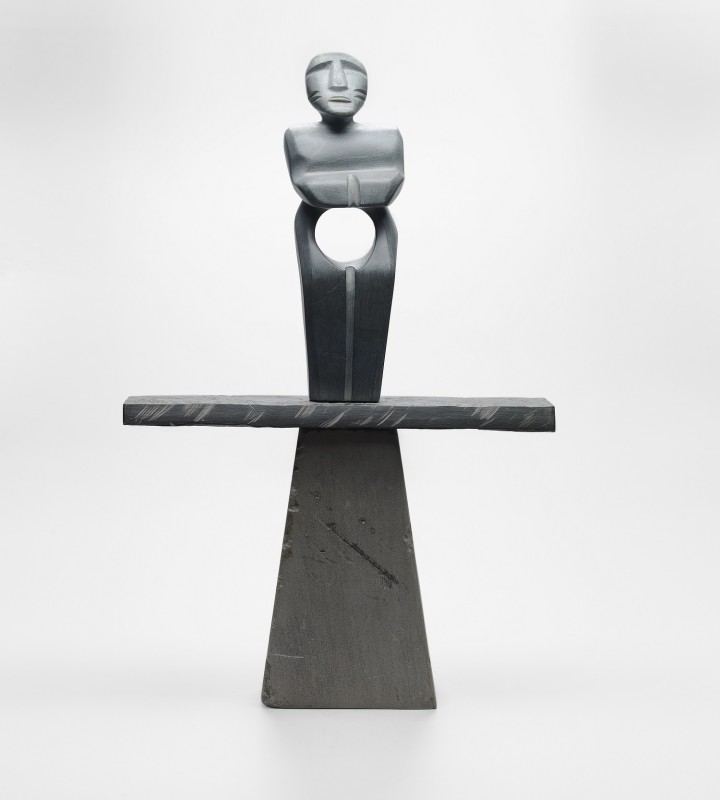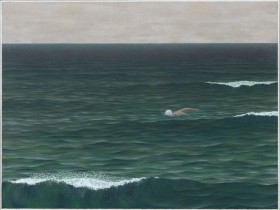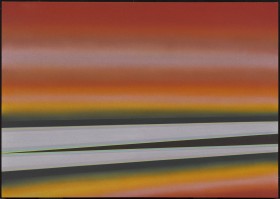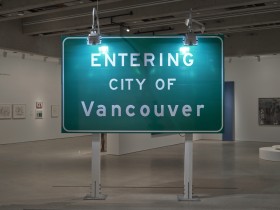Inuit Modern Symposium

David Ruben Piqtoukun. Guidepost, 1995. Limestone, Brazilian soapstone, slate, Overall (base: 104.6 x 635. X 36.8 cm): 94.5 x 61 x 14.5 cm. Gift of Samuel and Esther Sarick, Toronto, 2001 © David Ruben Piqtoukun 2001/412
Inuit Modern Symposium
It is not who we are, but where we come from and where we are going.
Join Inuit artists and thinkers as they reflect on this statement during a timely one-day gathering. This symposium, scheduled in conjunction with the opening of Inuit Modern: The Esther and Samuel Sarick Collection of Inuit Art, will explore questions posed by the exhibition. What are the current issues affecting Inuit art today and how has modernity complicated life in Canada's far North? How has Inuit art changed the way that Canada and Inuit are viewed internationally? These issues will be taken up by Inuit artists and scholars and others working in the field.
Recordings of the three one-hour sessions are now available online. Listen to online conversations with Inuit artists, scholars and your peers, right from your desktop.
Participants
Kenojuak Ashevak (b.1927, Ikirasak, Nunavut) At the age of eighty-four Kenojuak Ashevak continues the pace of creating art she began more than fifty years ago. She is a pioneer of Inuit modern art and the first internationally known Inuit artist. She was born on South Baffin Island and received her early art training at a Quebec City hospital where she was treated for tuberculosis. Known for her many interpretations of birds, she uses their shapes to explore line and colour and to produce fantastic designs. Her well-known 1960 stone-cut Enchanted Owl became a sought-after Canadian stamp in the 1970s. She is a Companion of the Order of Canada and won the Governor General’s Award in Visual and Media Arts in 2008.
Idris Moss-Davies (b.1974, Broughton Island) was raised in Broughton Island before moving south with his family. While living in Toronto he started carving, working alongside artists Manasie Akpaliapik and David Ruben Piqtoukun. His mother, Geela Alikatuktuk, carves in stone, ivory and antler, and is a talented tapestry artist.
Elisapee Ishulutaq (b. 1925, Kanirterjuak, Nunavut) began carving and drawing in 1970 when she moved from camp to the Pangnirtung settlement. Her work draws themes from camp life and first gained attention when it was included in the annual collections of the Pangnirtung Print Shop and the Pangnirtung Tapestry Studio. One of the leading graphic artists of her generation, Ishulutaq creates narrative scenes characterized by use of multiple perspectives and an exuberant, unselfconscious style.
Mattiusi Iyaituk (b. 1950, Akulivik area, Quebec) was born in a hunting camp not far from Cape Smith. He moved with his family to Ivujivik in 1955. In Montreal, he received police training, and became a policeman in Ivujivik. After receiving a Canada Council grant, he resigned from the force in 1984 to devote his time to carving and hunting. His early sculptures, dating from the 1960s, were heavily influenced by the work of his older brother, Nutaraaluk. In the late 1970s, Iyaituk developed his own "abstract" carving style, blending traditional subjects and techniques with innovative modern ones. He is noted for reviving the old community style of using ivory, bone, and antler inlay with dark soapstone, and drilling small dots to represent parka trim.
Jimmy Manning (b. Kimmirut, Nunavut, 1951) is an artist, photographer and retired print studio manager of the Kinngait Studios in Cape Dorset. Manning is an integral figure in the development of the West Baffin Eskimo Cooperative and of Inuit art in general. He adopted black and white photography in the 1970s as a tool for creating a cultural record of camp and community life, including the activity of fellow artists.
Michael Massie (b. 1962 Happy Valley-Goose Bay, Labrador) investigates both traditional and contemporary themes in his work. He has achieved renown for his innovative teapots that combine themes and symbols from his native Inuit culture with European traditions. Massie has been twice short-listed for the coveted Prix Saidye Bronfman and has an extensive international reputation. His work has been shown in North America and Europe, including the National Gallery of Canada.
Mathew Nuqingaq (b.1967 Iqaluit) grew up in Broughton Island, but now lives in Iqaluit. He has always been interested in being an artist even when he was a child. He started making jewellery in the mid 1990s after registering for an evening course at Arctic College, and received his Jewellery and Metalwork Diploma in 1999. Mathew works part time for Nunavut Arts and Crafts Association (NACA) and is also on the advisory committee for Canada Council and Secretary/Treasurer for the Inuit Art Foundation.
Aaju Peter (b. 1960, Arkisserniaq, northern Greenland) has lived up and down the west coast of Greenland as a result of her father’s teaching and preaching career. In 1971, at the age of 11, Aaju was sent to go to school in Denmark. She moved back to Greenland in 1978, and then relocated to Iqaluit in 1981. Here, Aaju raised her five children, went to school to study the Inuit language and culture, and volunteered for women’s organizations as interpreter. Currently Aaju has a home based sealskin garment business, interprets, volunteers for community events, collects traditional law from elders, is a graduate of Akitsiraq Law School and was called to the Nunavut Bar in 2008. Aaju is also an accomplished musician and released her first cd We Are Inuit in 2008.
Tim Pitsiulak (b. 1967 Kimmirut, Nunavut). While still living in Kimmirut, Tim Pitsiulak became interested in combining the local gemstones with gold and silver to make jewelry. After moving to Cape Dorset in 2004, he continued this interest, eventually earning a jewelry and metalwork diploma from Nunavut Arctic College in 2007. He is also a carver and is currently active in the Cape Dorset lithography studio. His first prints were released in 2009. Initially his subject matter was wildlife, especially caribou, but lately he has been drawing scenes of daily Cape Dorset life, including boats, airplanes and heavy construction machinery.
David Ruben Piqtoukun (b. 1950, near Paulatuk, Nunavut) is a sculptor strongly associated with the new artistic consciousness among Inuit. Originally from Paulatuk in the Inuvialuit region he now lives in Ontario. Living in the South and working in a variety of sculpting materials, he experiments with ideas of cultural self-reflection, such as spirituality, through art. Piqtoukun works in stone and metal, utilizing insets of bone, ivory or stone in contrasting colour. His multi-media sculptures are complex and often created in many parts. Drawing on Inuit, Alaskan and first Nations heritage, his works are filled with masks and shamanic transformation spirits, such as fish and bear spirit helpers.
Ingo Hessel is co-curator of Inuit Modern, Curator of the Museum of Inuit Art, Toronto, and the Albrecht Adjunct Curator of Inuit Art at the Heard Museum, Phoenix.
Heather Igloliorte is a contributor to the Inuit Modern catalogue, and an Inuk curator and art historian from the Nunatsiavut Territory of Labrador.
Gerald McMaster is co-curator of Inuit Modern and the Frederick S. Eaton Curator of Canadian Art at the Art Gallery of Ontario.




